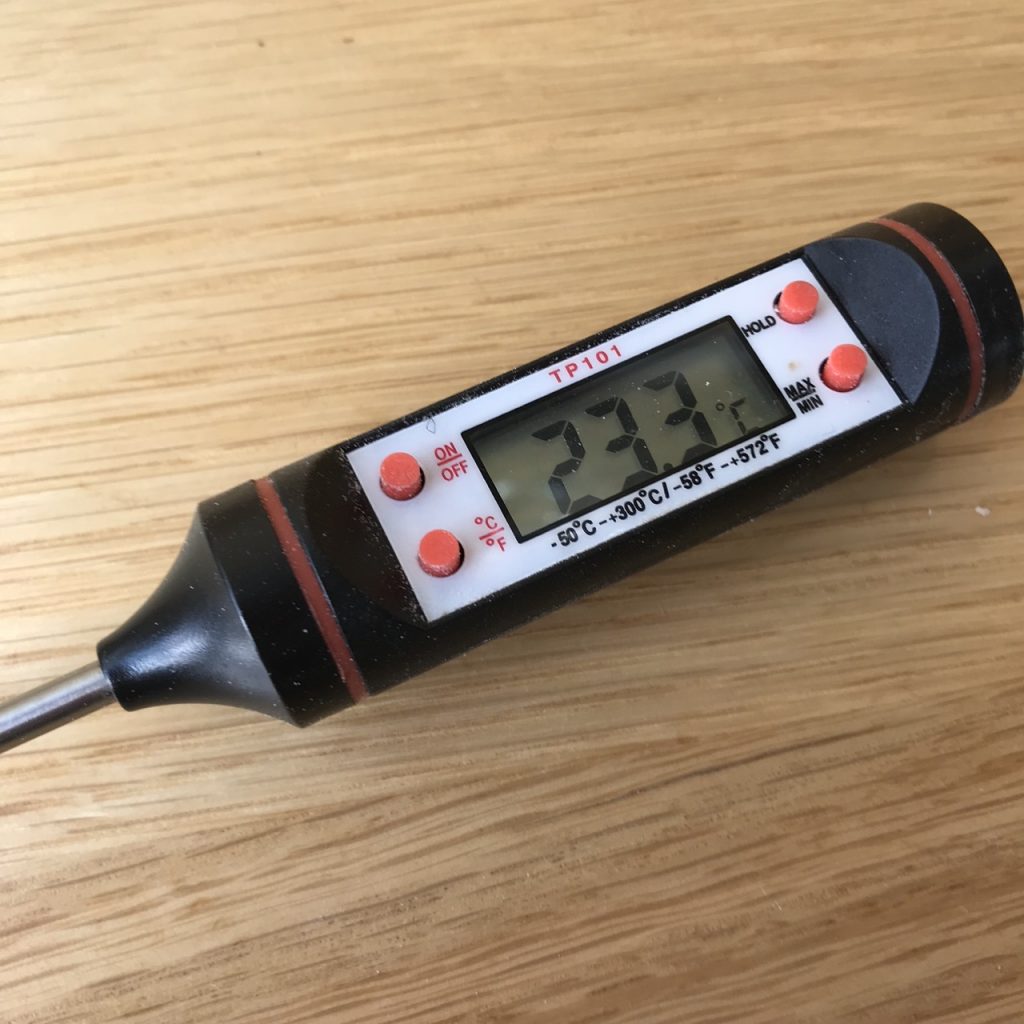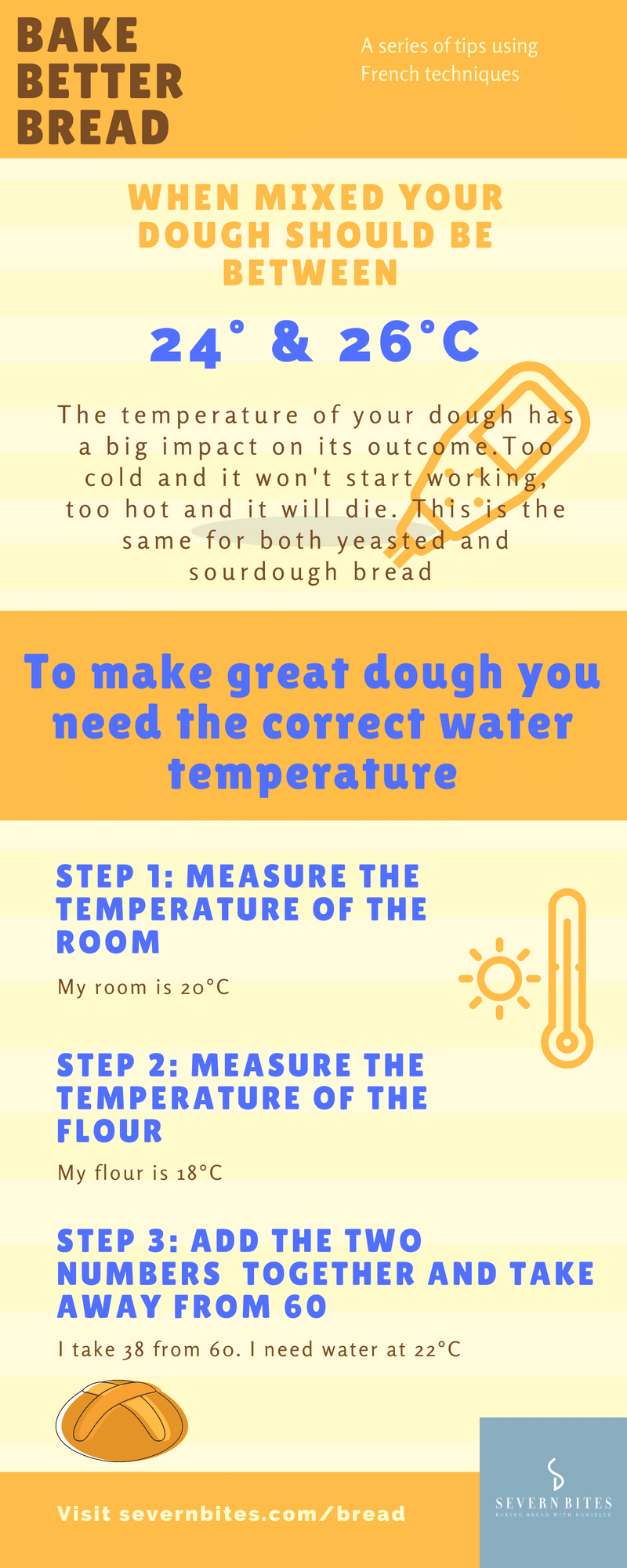Why dough temperature matters
Do you think about water temperature you add to your dough? Is water cold, warm or hot if it is tepid?
If the water is tepid, how warm is it? The dictionary definition of tepid is slightly warm or lukewarm. As an adjective, tepid means lacks enthusiasm, half-hearted, indifferent, cool. I think you’d agree that this is a woolly term at best and one that should be consigned to the bin. YET, there are so many bread recipes that call for tepid water. What temperature is tepid?
I’ve tested this at many of my bread making classes. I fill a jug with tap water and ask participants to describe the temperature. I ask is the water cold, tepid, warm, hot? Each person’s answer is different. If each of us follow the recipe that calls for tepid water, the results will be different as we’ll use different temperature water.
Why is temperature important?
The final temperature of a dough after mixing is one of the indications that the dough has been sufficiently mixed to a point where the yeasts are developed. Too low a temperature and the dough won’t rise well, too high and the dough will over-ferment. The ideal temperature is between 24°C and 26°C (75 to 78F).
Room temperature, flour temperature and water temperature are important
We have three factors to consider:

Room Temperature
You can well imagine there would differences if you make bread on a Polynesian island (as one of my former breadmaking classmates has to do) where it is 38°C or at the British Antarctic Survey at the South Pole where it approaches freezing.

Flour Temperature
Where has the flour been stored? Will it be the same temperature as the room? You’ll be surprised – even if it is in the same room, it is often cooler than room temperature.

Water Temperature
Depending on the time of year, the water temperature out of the tap will vary. You’ll know this if you let it run to get a really cold glass of water to drink. But water temperature is realistically the only factor you can easily change.
Using the Base Temperature formula
Whilst this is a simple formula, to begin with, just try using water at 22°C
There’s a really simple formula that can help you determine the correct water temperature – Base Temperature. You will need a digital thermometer (these can be obtained very cheaply). This works for temperature measured in Celsius.
Adding the temperature of the air, the water and the flour should equal 60.
- Check the air temperature it’s 18°C.
- The flour temperature is 16°C.
- Add these two together = 34°C.
- Subtract that from 60 (the base temperature) to give 26°C. This is the water temperature to use.
If the day were far warmer, say 24°C and my flour temperature is 20°C, my water temperature would be 16°C. For ease, round up the temperature if it is .5 or above, round down if it is .4 or below.
You might ask what you do when the air temperature is really hot. Bakers in very hot climates have to resort to storing the flour in a refrigerated location!
NB If you are hand kneading, I would be sure that the water temperature is no less than 22C
NB Some professional bakers use a different Base Temperature, but 60 is widely used. If you are using fahrenheit, check out King Arthur flour’s formula.

Checking your dough temperature
Use a tried and tested bread recipe, or one of my bread recipes and mix by hand or in a machine. This is relevant whether you are making sourdough or yeasted bread
Once you have kneaded the dough by hand for at least 10 minutes, check the temperature. Keep kneading if it has not reached 24°C/77F.
If you are using a stand mixer, planetary or spiral mixer, you will mix the dough at a low speed around 5 minutes, then on second speed for a further 5 minutes. This will vary on the power of the motor in your stand mixer. Check the temperature at this point. If necessary mix for a minute more and check again. It should be between 24°C and 26°C/ 77F
How do I know if my dough is ready?
There are of course other indications to tell you whether your dough is sufficiently mixed – the window pane test and whether the dough has come away from the sides of the bowl). For the window pane test lift up your dough and stretch it. It should have some elasticity. It will break eventually of course. If your dough is sufficiently mixed in a mixer bowl, it will come clean of the sides of the bowl.
What next?
Now for the magic bit, if your dough has reached the correct temperature, it will rise even in the fridge! No need to have a proofer.
Find out more
I run both in person and online classes. Hope to see you soon!

Bake Better Bread: Baker’s Percentages
Bake Better Bread: Pre ferment – Pâte fermentée
Bake better bread: Fresh Yeast


Write down the ingredients and steps as you go
How can I formulate my own bread recipes.